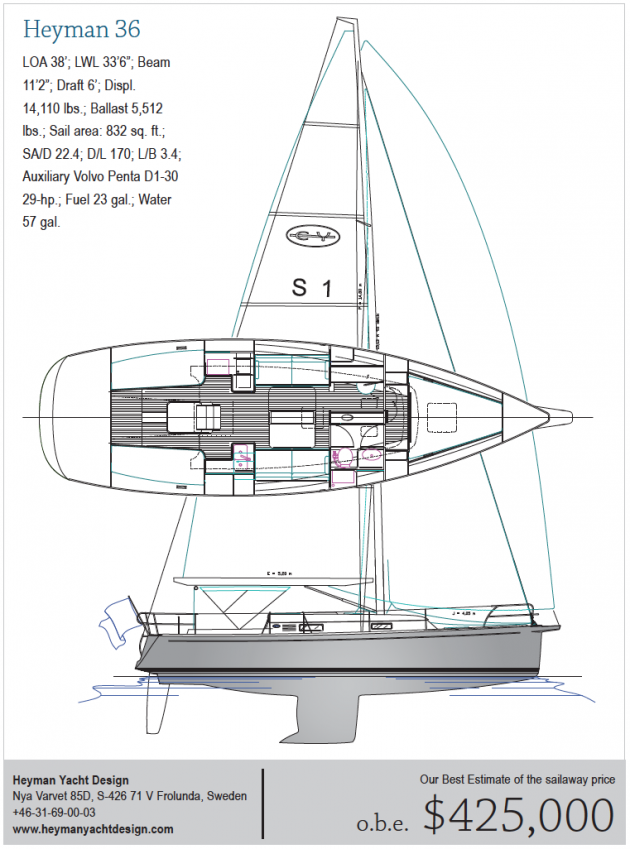Heyman 36
This is a very interesting design accompanied by some very interesting and very well-written designer's comments. Sometimes, I just get drawings and specifications, but in this case the designer, Gabriel Heyman, of Göteborg, Sweden, has made my job easier by writing out in detail his philosophy behind this design.
 The comments are very promotional, but they are also informative in a substantive way, and call attention to what the designer calls the "subtly radical" nature of this design. Think of this boat as a coastal racer-cruiser or a nice, comfy weekender
The comments are very promotional, but they are also informative in a substantive way, and call attention to what the designer calls the "subtly radical" nature of this design. Think of this boat as a coastal racer-cruiser or a nice, comfy weekender
The hull is of moderate displacement with a D/L of 170 and an L/B of 3.4. The entry is very fine with a half angle of entry of 14.4 degrees. I don't have a set of lines, but I suspect the DWL goes quite hollow near the stem. In plan view the distribution of beam is very normal, even indicating a bow on the full side. There must be a lot of shape change between the sheer and the DWL to get that narrow angle of entry.
The sheer is pretty straight, and with the moderate freeboard and truncated ends, it gives the hull a bit of a blocky look. Note the small skeg aft and the forward rake of the rudder stock. Mr. Heyman does not explain why he raked the stock opposite to the way almost all stocks are raked today. I'd like to know. Draft is modest at 6 feet but there is a deeper T-bulb racing keel available.
The designer says the emphasis in this design was on the cockpit, so we can easily see how that choice affects the interior layout. There are two layouts. Hull No. 1 will have two quarterberths. Hull No. 2 will have one double quarterberth to starboard and a bigger galley. We'll stick with hull No. 1 for this review.
The galley is split port and starboard. That is OK, but it means the cook might drip cooking liquids across the cabin sole. My complaint with this layout is the short settees. I think these short settees will determine the feel of the interior, and I think it's going to look cramped. If there are four aboard I'd like to see enough settee length to allow you to spread out a bit after dinner. Maybe I don't want to rub shoulders with Roger all night. The head is quite large and accessible from the saloon or the forward cabin. The nav station is adjacent to the head.
The deck has some very interesting features. The cabintrunk has a slight overhang to the top. LED lighting is tucked up under that overhang. Recesses are tooled into the outboard edge of the cabintop to allow lines running aft to be hidden. These lines exit the recess and lead to winches port and starboard of the companionway.
There is a anchor well forward.
The large cockpit has full-length seats with deep seat backs forward. There is no coaming where the helmsman sits, but that provides more options for comfortable helm positions. The entire aft end of the cockpit folds down to make a swim step.
One interesting feature of this deck layout is that the primary and secondary winches are mounted on the deck outboard of the coaming instead of on the coaming. I'd have to try that before commenting on its effectiveness. There is large, flush hatch in the cockpit sole to gain access to the volume below. The large-diameter wheel is recessed into the cockpit sole. This will be a very comfortable cockpit.
There is nothing unusual about the all-carbon rig. The SA/D is a healthy 22.4, and this boat can be effectively sailed with a non-overlapping jib. The sailplan seems to indicate a self-tacking jib but the deck plan shows no self-tacking hardware.
Interesting boat. It's a clean design and not a bad looking boat. I think this boat could work very well as a racer-cruiser.

Comments